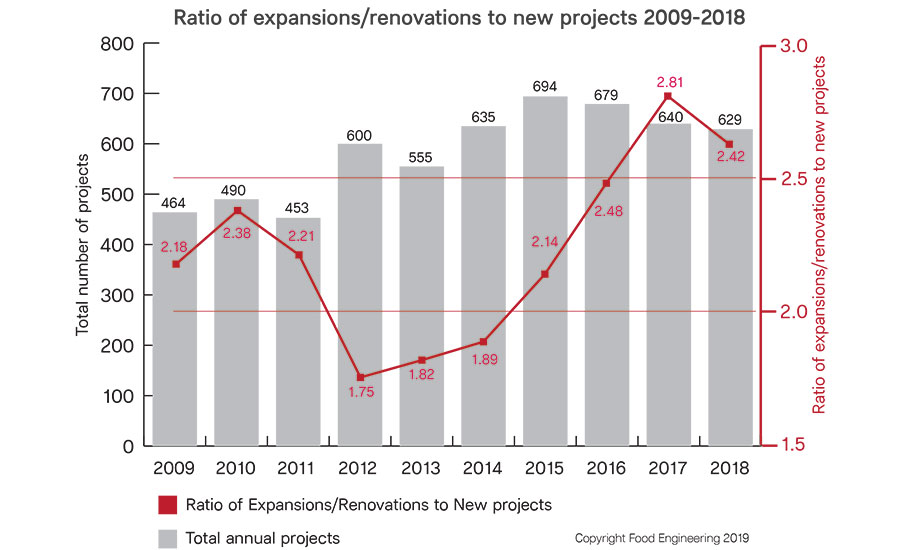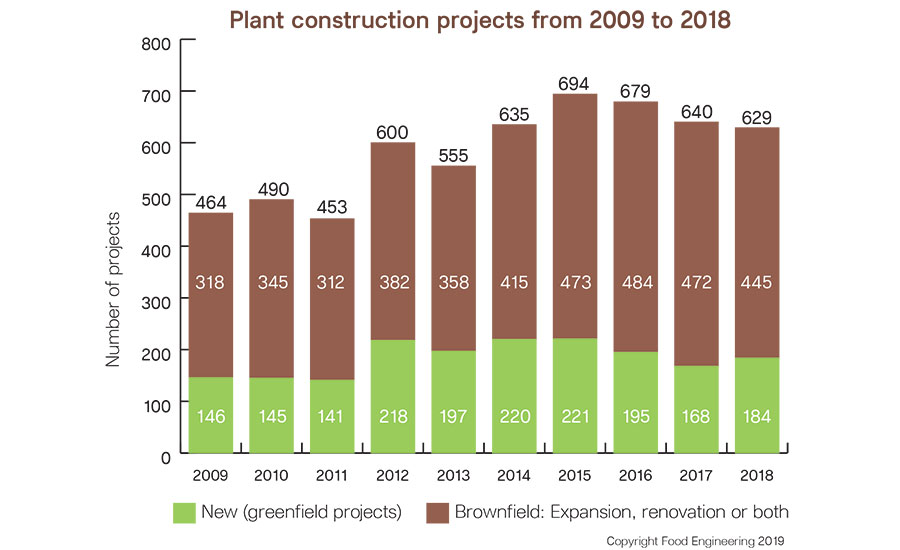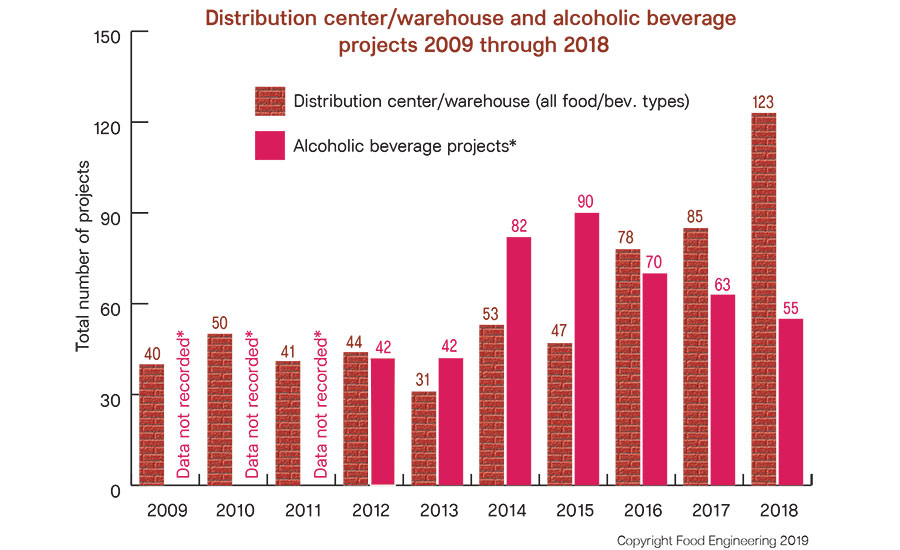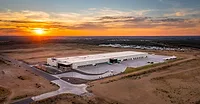Plant Construction Survey
Food Engineering's 2019 Plant Construction Survey shows tax cuts spur investment
Federal tax cuts have encouraged upgrades to existing food plants and construction of new plants, but finding qualified labor remains a sticking point

Click here to see the latest survey
Food Engineering’s 42nd annual Plant Construction Survey reports that construction projects are on the upswing thanks to federal tax breaks, continuing food and beverage industry consolidation and a desire for greater flexibility in production. However, fast-track construction schedules coupled with a shortage of skilled labor pose a challenge. Read on for an in-depth analysis of the numbers.
Article Index:
The good news: The economy is booming; last year’s tax cuts have made monies available for many companies to make large-scale plant improvements or replacements, and the cost of steel has begun to level off.
The bad news: When you enlist the expertise of an architecture/engineering/construction firm for your next plant modernization or greenfield project, expect to hear that the shortage of skilled tradespeople may increase the cost of your project or delay its completion.
Sorry to beat an old horse to death, but no matter whom you talk to that runs a company—whether food and beverage, machine builder, system integrator, job shop or A&E/C firm—it’s the same story. It’s really, really difficult to find skilled labor, and that ranges from qualified machinists, electricians and refrigeration technicians to engineers and automation experts.
In fact, many tradespeople are finding plenty of work (often with overtime to the tune of working 60 hours a week), with incomes rivaling or bettering those of college-trained professionals.
A couple of revelations
In spite of workplace labor shortages, this year’s FE Annual Plant Construction Survey actually contains a couple of surprises, and input from the A&E/C firms that helped with this survey bears them out. While not all firms reported these trends, counting all the projects in the 2018 list showed changes in direction compared to last year’s findings.
What did the survey reveal? First, though the 2018 total number of reportable food and beverage projects was down a couple of percentage points (possibly due to the number of proprietary projects not reported), the five-year upward trend of the ratio of expansion/renovation projects compared to new projects has finally reversed itself—meaning that a higher percentage of projects were new in 2018 (i.e., for every new project, there were 2.42 expansions/renovations)—compared to 2017’s 12-year high (for every new project, there were 2.81 expansions/renovations). [See the graph, “Ratio of expansions/renovations to new projects 2009-2018.” Also, take a look at the pie charts for the last four years in the graphic, “2015 through 2018 projects (percent of total).”]

In this graph, the gray bars represent the total number of projects each year from 2009 to 2018. The red trace shows the ratio of expansions/renovations to new projects. From 2012 to 2017, the ratio of expansions and/or renovations to new projects had increased, indicating in 2017 that about three out of four projects reported were expansions and/or renovations. In 2018, the trend has reversed, indicating a trend towards a greater percentage of new construction projects.
Second surprise: The number of warehousing and distribution center projects reached a 13-year high (the years I’ve been conducting the research) of 123 projects in 2018 compared to 2017’s high of 85 projects. Warehousing and distribution center projects include renovations and upgrades plus new structures for handling any food and/or beverage products.
Reportable food and beverage projects are those valued at more than $1 million. They have been made public by the processor, a government entity (including local or state economic development groups), or the A&E/C firms responsible for them. The survey includes projects begun, announced by any entity or completed in 2018. If dates listed are beyond 2018, they reflect the projected completion date for a project either announced in 2018 or currently underway. Keep in mind, some projects can be announced, then dropped at the last minute for any number of reasons, e.g., legal problems, lack of expected funding, site issues, changing needs, politics, etc. In the table, “D/W” refers to distribution/warehouse, and “DC” refers to distribution center; “Exp.” refers to expansion, and “Ren.” is for renovations, and some projects include both.
A thorough look at the numbers
As said, 2018’s total number of reportable food and beverage projects of 629 was down 1.7% compared to 2017’s total of 640 projects. The year 2015 represented the highest number (694) of projects in the last 13 years. In terms of averages, 2018’s total number of projects was 7.7% higher than the 10-year average of 584 projects per year. See the graph, “Plant construction projects from 2009 to 2018.”

New facilities (green) and expansions/renovations (brown) are shown for years 2009-2018. Total projects = New + Exp./Ren.
Expansions and renovations in 2018 numbered 445 projects (about 70% of the total), and new projects accounted for 184 (about 29%), reversing the trend of an annually increasing ratio of expansions and renovations compared to new projects since 2012. The ratio of expansions and renovations in 2018 compared to new projects decreased from 2017.
The number of new projects for 2018 (184) increased by 9.5% compared to 2017’s number of 168 (just 0.3% over the 10-year average of 183.5 projects per year). The number of expansions and renovations in 2018 actually decreased from 472 recorded in 2017, a loss of 5.7%—still an 11.1% improvement over the 10-year average of 400 projects per year.
Meanwhile, dedicated warehousing and distribution center projects numbered 123 in 2018, the highest I’ve seen in 13 years of doing this survey. This number increased from 85 projects recorded in 2017, a jump of nearly 45% and a 108% gain over the 10-year average of 59 projects per year. Warehouse and DC projects include new facilities and expansions/upgrades.
Projects dedicated to alcoholic beverages (including new, expansions and upgrade projects, plus warehousing/DCs) numbered 55 in 2018, a nearly 13% decline compared to 63 projects in 2017. The 2018 number reflects a decline of about 13% from a seven-year average of 63.4 projects per year. While warehouse/DC projects accounted for 19.6% of 2018’s total projects, alcoholic beverage projects represented 8.7% of the total. (For a graphic representation of warehousing/DCs and alcoholic beverage projects, see “Distribution center/warehouse and alcoholic beverage projects 2009 through 2018.”)

For the past seven years, FE has been tracking alcoholic beverage producing or warehousing facilities. Though fewer projects were listed in 2018 than 2017, craft beer and distillery projects accounted for the majority of projects. In 2018, the number of distribution center/warehouse projects for all food and beverage types reached a peak in the last 10 years. The DC/Whse. category includes both new facilities and expansions but only projects dedicated to distribution and warehousing (no processing).
Incidentally, for the first time, I counted the number of dedicated pet food projects: 26 in 2018, which includes all types—large to small and new builds, upgrades/expansions and warehousing and DCs. This number represents 4.1% of 2018 projects.
Growth, economy and expectations
Growth is good—but, as we’ll see, not completely without its problems.
“The Trump administration has lowered corporate taxes and eased regulations, allowing companies to invest in their facilities,” says Jim Larva, Food Plant Engineering project manager.
“Due to the Trump tax breaks and favorable climate for business, capital spending has increased,” says Keith Perkey, Haskell Company VP—food & beverage division leader. Clients are taking advantage of the opportunity to invest in large capital projects, often to replace facilities that are nearing the end of their useful life and can be replaced with a much more efficient facility and manufacturing system.
“One major trend we have observed among our clients is the reintroduction of infrastructure improvements into capital planning and execution,” says Noah Schneider, CSM Group project director. The focus on infrastructure in parallel with production projects is cyclical and is typically tied to the stability of the market. Instead of looking for short-term gains like they have in the past, CSM’s clients are making long-term investments in building components.
When processors aren’t replacing facilities outright, they are modernizing them as they move from manual labor to automation, says John Koury, A M King architect.
FSMA is still affecting design, although most processors have caught up with compliance. Another major trend is a focus on sanitation, reports Mark E. Galbraith, co-owner of Galbraith Pre-Design. Sanitation is key in the design, construction and maintenance of facilities, and it will affect the consideration of construction materials and processes.
With the positive economy, the surge in capital projects has caused an increase in costs for construction materials and services.
“We saw a spike in steel prices at the beginning of 2018 due to tariffs, but that did correct somewhat as the year progressed,” says Perkey. “Of course, no customer, nor contractor, likes higher prices or extended schedules due to the surge in capital spending.”
Top 10 A&E/C Hot Trends
by decreasing order of importance
- Fast project deployment
- Overall cost/controlling costs
- Workplace safety
- Food safety: FSMA regulations/GFSI (design. layout, etc.)
- Increasing production to meet demand
- Flexibility in plant design to accommodate flexible manufacturing
- Ability to change design when building
- Raw vs. cooked (RTE) side design
- Site location related to transportation, logistics, utilities
- Virtual reality/augmented reality/3-D facility design tools
*Last three tied with same score
Top 10 Hot Trends A&E/C Firms Say are of Most Concern to Food Processors
by decreasing order of importance
- Fast project deployment
- Overall cost/controlling costs
- Food safety: FSMA regulations/GFSI (design, layout, etc.)
- Workforce availability (tech staff)
- Automation: process control, robotics, packaging, etc.
- Flexibility in plant design to accommodate flexible manufacturing
- Capital availability
- Increasing production to meet demand
- Workforce availability (line workers)
- Allergen separation design
You want it faster?
Everybody wants fast project deployment—and this year’s “Top 10 A&E/C Hot Trends” and “Top 10 Trends A&E/C firms say are of most concern to food processors” both showed fast project deployment an overwhelming No. 1 compared to last year, when it scored fourth and sixth respectively. Last year, food safety/FSMA scored top honors for both categories.
The problem is that processors are seeking faster projects for less money, says Larry Klein, CRB regional leader. The industry is trying to increase productivity in the construction period. To help the situation, A&E/Cs are resorting to modularization and prefabrication techniques to bring projects in on a tighter schedule and at a lower budget.
Getting projects done fast at a busy time can be a challenge. Right now, subcontractors are staying busy, says Mark Redmond, Food Plant Engineering president. Compressing schedules is becoming more difficult because of lead times on equipment, especially with electrical gear. Equipment manufacturers are at the longer end of their lead times as are construction schedules. This is because of the current economic environment. Companies have an opportunity to expand right now but are not accomplishing their goals as quickly as they’d like.
With this shortage of contractors, food processors need to think about location and available workforces to complete their projects on time.
“General contractors, construction managers and design-builders continue to face challenges with securing enough qualified construction field labor and management,” says Tyler Cundiff, vice president, business development, Gray Construction. “Our customers have listened to our subject matter experts in this field and have had to carefully consider where and how to grow their business knowing that construction capital cost, as it relates to ROI (especially if it’s a new product), is not insignificant.”
Good times for subcontractors?
While there has been a steady increase in the cost of construction projects, it was mainly due to material price increases related to the steel market. However, that seems to have leveled out over the past year, says Nathan Larose, CMC Design-Build director of project development. “Prices have continued to rise mainly due to a very tight subcontractor market, especially in the mechanical and electrical trades.”
Though an active market affects the cost and availability of building materials, labor is the real sticking point, says Todd Allsup, Stellar vice president of sales, food group. “Overall, the construction labor market is tightening as well, so finding subcontractors that are ‘hungry’ is also more difficult. This is especially true when it comes to specialized labor required to build many food processing facilities. This can lead to increased project execution costs and schedule changes.”
Wherever your project is located—West Coast, East Coast, South or North, finding skilled, qualified subcontractors remains a challenge. This includes all trades, from pipefitters to electricians to insulated metal panel installers.
“One of the biggest issues we see in the industry is the lack of skilled labor,” says Chris Jarc, Hixson Architecture & Engineering vice president and project manager.
Because of that lack of skilled labor, subcontractors can be highly selective as to which jobs they bid upon. They are being offered incentives above the typical union rate and are usually guaranteed 58-hour work weeks with per diems as an enticement to travel to jobsites. And when you are looking at specialty subcontracting, such as ammonia refrigeration, the challenge of securing qualified subcontractors is even more difficult, adds Jarc.
While construction employment is at an all-time high, the lack of skilled labor has a mushrooming effect on all parts of construction projects, says Heath Catt, project manager, Burns & McDonnell construction/design-build group. “We’re not seeing new entrants into the industry at a volume that is keeping pace with demand, creating a shortage of skilled labor across all regions of the country.”
It is more important than ever to understand labor availability in your area and competing projects. Labor impacts are not limited to field construction. The shortage of skilled labor affects shop production for suppliers/fabricators, driving up the prices of manufactured equipment and other construction goods, says Catt.
What’s driving projects?
Money! And mergers and buyouts. That’s the short answer. There seems to be more money coming from private equity, says Greg Carr, The Austin Company senior director of project planning. In some cases, buyouts and mergers and acquisitions (M&As) may provide a stimulus to scrap old, nonconforming plants and build new, where automation and food safety can be designed in.
Jim Cathcart, senior director of project planning for Austin, notes that consolidations and M&A activity is a mixed bag—some result in canceled projects, while others cause new projects to happen. “Greenfield plants make sense in regions with favorable investment incentives, adequate infrastructure, reliable labor and affordable utility rates, etc.”
Alex DeMartini, project executive at Clayco Inc. reports a balance of greenfield and upgrade/expansion work. While the political climate may have caused some uncertainty and delays in the past, buyouts, consolidations and mergers/acquisitions have largely come about as food companies try to adapt their businesses to changing consumer trends, and these situations today have been affecting projects more than the political climate.
“Adapt” may be the operative word. “With industry consolidation, we’re seeing the same adaptable lines for consolidating overlapping products/processes as when a competitor buys another out,” says A M King’s John Koury. “They are also taking asset and process inventory and finding, in some cases, there isn’t more production space needed but rather more storage space.”
Consolidation is ongoing as new products and companies grow then get purchased by an established player thinking at scale or leveraging distribution, says Koury. The first move isn’t normally to acquire then build a new facility. Rather it’s to plan for the near future with existing facilities, then plan for a new facility as the process scales up.
Since the new tax law was passed, there has been a big increase in capital spending, says Chris Freeman, Burns & McDonnell food and consumer products group. What’s been driving this is greater interest in protein foods, salty snacks and better-for-you products. Though many of these industries are spending money on big upgrades, greenfield plant investments are usually found in the dairy and meat processing sectors, says Freeman.
When a lot of cash isn’t available, there may be other options. Allsup of Stellar Food Group describes an alternative approach to building “new.”
“A recent trend I noticed is that more food and beverage processors are going the developer route when it comes to building new,” Allsup says. “Rather than investing capital in a new building, these companies will lease from a third-party developer who builds and maintains ownership of the facility. These tenant improvement arrangements typically involve a long-term lease, such as 10 to 15 years. In these scenarios, rent payments are rolled into the facility’s operating costs.”
This trend speaks to the continuing influence of emerging companies disrupting the food industry, adds Allsup. Startups and smaller companies are typically more capital sensitive, so going the developer route is a lot more feasible.
Flexibility and change—the new normal
Consumers wanting healthy, flavorful food that is safe and allergen free has put a lot of pressure on processors to create facilities that contain flexible lines and spaces with easy-to-clean equipment and surfaces, plus safe environmental spaces with clean airflows and segregation of allergens—all a tall order for some aging plants.
Planning for the long-term future of a plant is much more important today than it was years ago, says Greg Marconnet, vice president—food & beverage, Mead & Hunt. Flexibility in design and long-term planning allow processors to meet the needs of the consumer as they build the plant, while remaining nimble enough to adapt as consumer tastes change, and therefore, products change. This means being able to make changes to the layout of the plant easily but also building the first time with expansion in mind.
The key is to offer as much flexibility as possible during plant design because processors will need to offer a variety of products on one or two lines, says Michele Loppnow, ESI Group USA marketing manager. This flexibility requires the need to design areas that allow for quick cleanup capabilities so a processor can easily change product lines. Many processors do this through building a larger production space with multiple product rooms, more test kitchens and more rooms designed and prepped to offer multiple conversion options (i.e., cooler to freezer or freezer to blast freezing). “In some cases, we have seen processors build an entire separate facility on campus in order to meet allergen and food safety demands but still maintain the flexibility in those facilities to change products as consumer trends change,” says Loppnow.
From a layout standpoint, greater flexibility means more open spaces and flexible equipment, says Emily Diersing, Food Plant Engineering process engineer. However, sometimes greater flexibility means more manual operations and less automation. This flexible space can be designed in a food-safe manner that makes it easier to change as necessary. The presence of food allergens in a product creates a heightened awareness to sanitary design. Properly designed equipment reduces the opportunities for traces of product to remain on equipment after washdowns, which causes cross-contamination.
To preserve freshness and accommodate shorter shelf life, many processors are searching for ways to shorten the distance from the facility to the consumer, says Stellar’s Allsup. For example, some companies are shifting away from a centrally located warehouse that services the whole country and using regional distribution centers that are closer in proximity to the end user. Another strategy is using more locally sourced ingredients to shorten distribution cycles. All of this has further highlighted the importance of designing and building facilities that are flexible and nimble.
Being flexible to accommodate change
Maybe call this concept of decentralized warehousing and distribution the “Amazon effect.” Proof enough is a half dozen Amazon cold-storage facilities appearing in this year’s project table. There’s another aspect of flexibility that the Amazon effect is creating, and that is in packaging, says Allsup. Since Amazon is gearing up for home delivery, packaging for home delivery will need to be different than retail. This means that packaging lines will have to be able to shift, and A&E/C firms and system integrators must be ready to design flexible lines to accommodate packaging for this new mode of delivery.
“For decades, dedicated lines dominated food manufacturing, but short product lifecycles now dictate the need for flexibility,” says Mary Frances Stotler, Dennis Group director of sustainability. Modular processing systems are a solution to help manage the complexity of today’s rapid-pace environment. When compared to traditional equipment, “plug-and-play” modular skids offer a condensed timeframe between design and startup since they are fabricated and tested offsite and generally have a smaller footprint, more easily fitting into a line with tight spaces.
“For decades, dedicated lines dominated food manufacturing, but short product lifecycles now dictate the need for flexibility.”
– Mary Frances Stotler
With all the last-minute changes in plant design necessary to make spaces flexible and food safe, A&E/C firms are having to be flexible as well.
“Clients are reviewing Integrated Project Delivery and Collaborative Design Build contracting techniques to drive optimization of plant square footage, project commercialization schedules and engineering solutions that future-proof facilities through column spacing, clear heights, ability to floor load or externally locate HVAC equipment, etc.,” says Jonathan Marshall, senior vice president, industrial, Faithful+Gould.
Just because A&E/C firms have the tools to accommodate design changes during a project doesn’t mean a processor shouldn’t do its homework before calling on an A&E/C firm for a new project. Many food processors are trying to cut upfront costs and proceeding at increased risk without adequate engineering definition on projects being submitted for funding approval, says Jens Ebert, PE, PMP, SSOE Group. Clients are reducing their in-house engineering resources and becoming more dependent on external service providers to guide them through their capital projects.
“While we have many clients that take advantage of our frontend engineering services (feasibility assessments, facility and process simulation, etc.), I am consistently surprised by clients that seemingly omit this project planning step and ‘dive into the deep end’ with regards to often substantial capital investment,” says Jon Scales, Epstein senior project engineer—industrial. These types of frontend analyses can often provide valuable insight and even result in cost savings or avoided risks over the course of the project that may not have been identified or implemented otherwise.
FSMA: Processors get it
“Plants are up to speed on FSMA now,” says Galbraith. Maybe that’s why FSMA dropped down to No. 3 and No. 4 on the two Top Trends Surveys this year, when it was the top concern last year for processors and A&E/C firms.
“I am noticing that plant staffs are much more aware about maintaining compliance,” says Galbraith. “And they are more aware and proactive when deficiencies arise. In most cases, they notice and resolve deficiencies much more proactively than when the new regulations were first implemented.”
Processors have become very concerned with ensuring that high-care and low-risk employees/operations are fully segregated through sanitary design principles, says CMC’s Larose. In the past, much of this was done through management practices, but now they are looking for actual physical separation.
Planning for employee behavior can be one of the more challenging components of developing a sanitary design, says Epstein’s Scales. Accomplishing this effectively requires placing fixtures, signage and interactive elements in such a way as to passively encourage hygiene at every step of an employee’s journey through the facility.
“We have seen increases in the levels of procedural plant security requirements but not to the point of driving capital projects,” says Matt Williamson, director of engineering at ADF Engineering. However, he says the need for physical separation of allergens and non-GMO raw materials has generated some capital spending.
Facilities are investing in infrastructure, and this can include product separations and segregations, says CSM Group’s Schneider. This is done by reformatting existing production lines and cleaning processes to align with current guidelines and processes. “We have also observed projects that improve control of personnel flows through designated pathways and enclose exposed exterior access points. Once the personnel are on-site, the new expectation is that their environment is controlled and monitored through facility design rather than through training and education,” adds Schneider.
Automate to survive in the long term
We know that automation will play an ever increasing role in today’s plants, though many people can be baffled by hyperbole and technical mumbo-jumbo. Joe Badalamenti, SSOE Group business development director, has seen an interest in Industry 4.0 integration, even though most clients don’t necessarily know what it is. More down to earth, however, is an increasing interest in implementing machine safety systems, as OSHA has been imposing hefty fines on unsafe equipment and operator injuries.
Perhaps the main reason to install sensors and devices to monitor and control plant utilities and production processes is to reduce expenses, says Harlan VandeZandschulp, PE, president of Gleeson Constructors & Engineers.
Williamson reports clients having an increased interest in automation to reduce changeover time and decrease losses during transitions. Meanwhile, some processors upgrade their automation in an incremental process that keeps costs in check and improves control.
“For many of our clients running on a Rockwell automation platform, we are seeing a migration from the machine edition (ME) to the site edition (SE),” says Dennis Group’s Stotler. The ME environment requires that changes must be implemented on each individual HMI; the SE version provides control on a centralized workstation. This provides better transparency and meets the needs of engineering, maintenance and operations.
Integrating building automation and process control is becoming the norm. Clayco’s DeMartini sees a tremendous interest in building automation and process control systems. Designs are taking automation into full consideration as the cost to automate building systems is coming down considerably, and ease of use is improving.
What used to be cutting edge in building management systems has become routine in most projects, says Perkey. IIoT is bringing more usable data from plant floor systems and making it available for maintenance as well. Plus, video systems are used for both security and production monitoring. Control networks in processing and packaging systems have become more reliable and easier to install; the automation in both areas adds flexibility to product offerings and packaging.
A handful of processors have reported large increases in mechanizing warehouse operation, including total automation from incoming to the loading of outbound trucks.
“In warehouses, we’ve seen an increase in density,” says Tom Rychlewski, CRB project manager. “Warehouse operations can be highly automated. While visiting a client in Europe, we toured a pet food plant that was fully automated, from the very beginning of the process to loading the truck. There were very few hands that touched the product. The product was racked, stored, unracked and loaded on the truck, all using automation.”
While automation can represent a large capital cost, obviously it can reduce labor costs. And Steve Tippmann, executive vice president of Tippmann Group, sees “creativity in automation as a way to supplement labor shortages in peak demand.”
But for some processors, automation might just be a lifeline, according to Haskell’s Perkey, “I recently heard one manufacturer say they were not automating to drive labor savings, but for survival. As they had attrition in their labor force, they cannot replace the people and need to automate to keep production moving.”
A M King
www.amkinggroup.com
Dean Snyder Construction
www.deansnyder.com
Hixson Architecture & Engineering
www.hixson-inc.com
ADF Engineering, Inc.
www.adfengineering.com
Dennis Group
www.dennisgroup.com
Mead & Hunt
www.meadhunt.com
Alberici
https://alberici.com
E.A. Bonelli + Associates Inc.
www.eabonelli.com
Shambaugh & Son, L.P.
www.shambaugh.com
ARCO National Construction
www.arconational.com
Epstein
www.epsteinglobal.com
SSOE Group
www.ssoe.com
Burns & McDonnell
www.burnsmcd.com
Faithful+Gould
www.fgould.com
The Austin Company
www.theaustin.com
Clayco Inc.
www.claycorp.com
Food Plant Engineering LLC
www.foodplantengineering.com
The Haskell Company
www.haskell.com
CMC Design-Build Inc.
www.cmcdesign-build.com
Galbraith Pre-Design Inc.
www.gp-inc.com
Tippmann Group
www.tippmanngroup.com
CRB
www.crbusa.com
Gleeson Constructors & Engineers LLC
www.gleesonllc.com
CSM Group
www.csmgroup.com
Gray Construction
www.gray.com
Looking for a reprint of this article?
From high-res PDFs to custom plaques, order your copy today!







